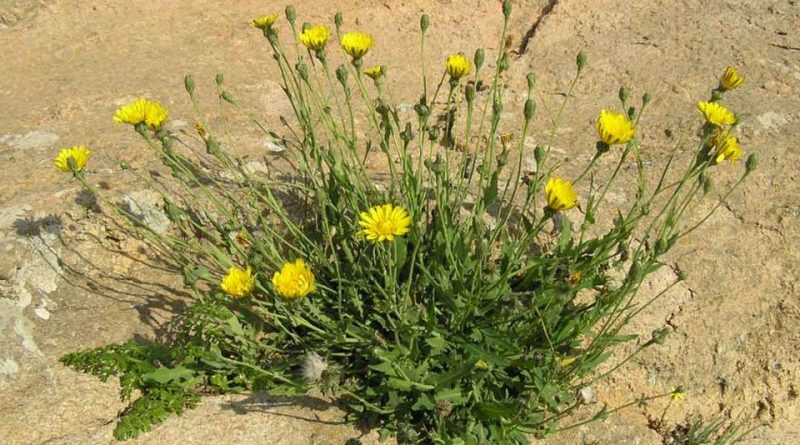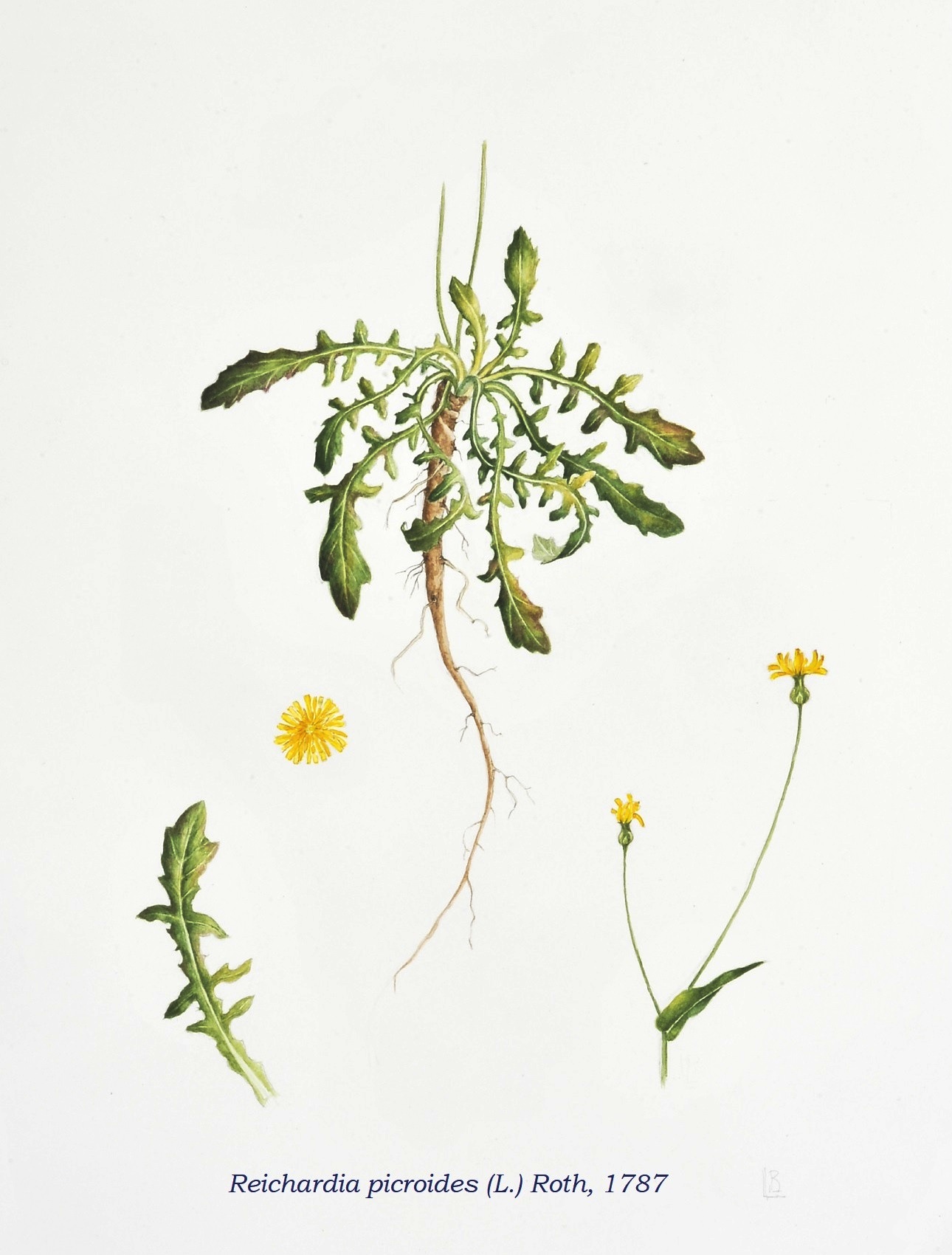Reichardia picroides
Reichardia picroides
The Common brighteyes (Reichardia picroides (L.) Roth, 1787) is a herbaceous species belonging to the Asteraceae family.
Systematic –
From a systematic point of view it belongs to the Eukaryota Domain, Plantae Kingdom, Spermatophyta Superdivision, Magnoliophyta Division, Magnoliopsida Class, Asteridae Subclass, Asterales Order, Asteraceae Family, Cichorioideae Subfamily, Cichorieae Tribe, Sonchinae Subribe and therefore to the Genus Reichardro edides Species .
The basionism is Scorzonera picroides L.
Other synonyms for this plant are:
– Picridium maritimum Rchb. f., nom. illeg .;
– Picridium picroides (L.) H. Karst .;
– Picridium vulgare Desf., Nom. illeg .;
– Reichardia integrifolia Moench, nom. illeg .;
– Hypochaeris hirta Ucria.
Etymology –
The generic term Reichardia was dedicated to the German physician and botanist Johann Jacob (Jakob) Reichard (1743-1782) from Frankfurt.
The specific epithet picroides comes from the Greek èidos = similar to, and Picrís that is similar to the genus Picris, due to the similarity with some species of this genus which in turn derives its etymology from the Greek Pix-ròs = bitter, unripe.
Geographical Distribution and Habitat –
The Common brighteyes is a Mediterranean species with continuous presence on the territory and quite common both in Europe and in Asia and Africa.
In Italy it is a fairly common species, while outside Italy it is present in some French Alpine departments (Alpes-de-Haute-Provence, Alpes-Maritimes, Drôme, Isère), and in the Massif Central and the Pyrenees.
The habitat is that of the sea cliffs, uncultivated arid, walls and along the streets but also the fields, crops and ruderal areas where it grows mainly on calcareous soils but also calcareous / siliceous with basic pH, low nutritional values of the soil that must to be arid.
It can be found from sea level up to 1200 m. s.l.m ..
Description –
Reichardia picroides is a perennial herbaceous plant 20 – 40 cm tall, glaucous, glabrous and generally smooth.
The root is woody, elongated and enlarged which contains a sweet latex, from which a more or less smooth basal leaves rosette develops, with a variable shape: elongated-obovate, oblanceolate, whole or variously divided into patent, jagged and ruffled lobes, restricted to the base in a long winged petiole.
In the spring period, erect or prostrate-diffuse, cylindrical-angular, simple stems or with one or two bifurcations are formed, with oblong, sessile, amplessicauli and whole lanceolate leaves, the upper ones reduced.
The inflorescences are racemate with 1 – 5 calatids carried by long monocephalic peduncles, enlarged at the apex, with some sharp bracts at the apex, heart-shaped at the base, and scarce at the margin, similar to the external ones of the envelope.
The envelope is globular – pyriform, more or less strangled, with bracts in several embryonic series, the external ones similar to those of the peduncle and the longer internal, lanceolate, all lacking in the margin.
Bare receptacle (without scouring pads) with yellow flowers, all ligulate, the exterior usually with a dark, brown or purple strip on the lower page.
The antesis occurs all year round and pollination is entomogamous.
The fruits are 2-3 mm cipsele with soft white pappus, the dark external ones with 4 wrinkled ribs, the thinner, lighter, sterile and more or less smooth ones.
Cultivation –
The Common brighteyes is a plant that reproduces by means of seeds following entomogamous pollination.
The seeds falling to the ground, after being transported for a few meters by the wind thanks to the pappus, then with anemocora dissemination they disperse dispersed mainly by the work of insects like ants (myrmecoria dissemination).
To use this plant, the tender leaves of the basal rosette must be collected and cut by cutting them at the height of the collar in order to allow them to grow back.
Uses and Traditions –
This plant has a great variability (especially in the shape and consistency of the leaves) which is why it has been attributed various varieties, some of doubtful taxonomic value; among these we remember:
– Reichardia picroides (L.) Roth var. intermediate (Sch.- Bip.) Flowers: annual with entirely yellow corollas;
– Reichardia picroides (L.) Roth var. vulgaris Flowers: with thin basal leaves and with 7-12 lacinias per side;
– Reichardia picroides (L.) Roth var. integrifolia (Moench) Kuntze, which would represent the most common subspecies;
– Reichardia picroides (L.) Roth var. maritima (Boiss) Flowers: with all pinnate leaves and fleshy lamina;
– Reichardia picroides (L.) Roth var. crassifolia Nob.:similar to the previous one but with the upper leaves almost whole;
– Reichardia picroides (L.) Roth var. cupaniana (Nicotra) Flowers: leaves all with whole blade only toothed on the edge;
– Reichardia picroides (L.) Roth var. halophila (Sommier) Flowers: similar to the previous one, but with fleshy leaves.
This plant, due to the presence of some active substances (rich in polyphenols), has nutraceutical properties: it is in fact a diuretic, refreshing, purifying, analgesic, antiscorbutic herb.
The fresh chopped leaves applied on the painful part relieve toothache, headache and myalgias.
The parts used are the leaves and roots. The leaves of this plant are edible (raw in salads or cooked), as are the roots.
Preparation method –
Reichardia picroides is perhaps one of the most appetite and sought-after spontaneous plants for use in the kitchen: the most tender leaves of the basal rosette eaten raw are an excellent salad by themselves or with other edible herbs with which they are also used boiled and seasoned with oil and salt or in the preparation of cakes, soups, soups and pies.
Guido Bissanti
Sources
– Acta Plantarum – Flora of the Italian Regions.
– Wikipedia, the free encyclopedia.
– Treben M., 2000. Health from the Lord’s Pharmacy, Tips and experiences with medicinal herbs, Ennsthaler Editore
– Pignatti S., 1982. Flora of Italy, Edagricole, Bologna.
– Conti F., Abbate G., Alessandrini A., Blasi C. (edited by), 2005. An annotated checklist of the Italian vascular flora, Palombi Editore.
Warning: Pharmaceutical applications and alimurgical uses are indicated for information purposes only, they do not in any way represent a medical prescription; therefore, no responsibility is accepted for their use for healing, aesthetic or food purposes.


